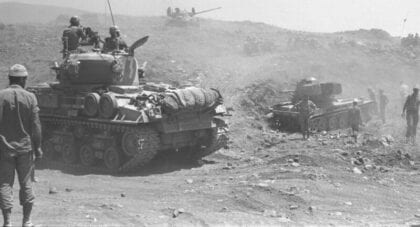Given the support of several powerful players, the Road Map overshadowed several other initiatives – all on the basis of a two-state-approach.
Introduction
 Given the support of several powerful players, the Road Map, after its launch, overshadowed several other initiatives – all on the basis of a two-state-approach. An example is the initiative of the then Crown Prince Abdullah of Saudi Arabia, which was endorsed by the League of Arab States during a summit in Beirut (League of Arab States Peace Initiative of 28 March 2002). Like the 1981 Fahd Plan, it demanded ‘full Israeli withdrawal from all the territories occupied since 1967’ (West Bank, including East Jerusalem, the Gaza Strip, and the Golan Heights), the establishment of a sovereign, independent Palestinian state with East Jerusalem as its capital and a ‘just solution’ for the refugees. Unlike the Fahd Plan, the Arab States in exchange explicitly offered ‘normal relations with Israel‘ in the context of a comprehensive peace. The initiative would again be endorsed by a League summit in Riyadh (Saudi Arabia) on 29 March 2007.
Given the support of several powerful players, the Road Map, after its launch, overshadowed several other initiatives – all on the basis of a two-state-approach. An example is the initiative of the then Crown Prince Abdullah of Saudi Arabia, which was endorsed by the League of Arab States during a summit in Beirut (League of Arab States Peace Initiative of 28 March 2002). Like the 1981 Fahd Plan, it demanded ‘full Israeli withdrawal from all the territories occupied since 1967’ (West Bank, including East Jerusalem, the Gaza Strip, and the Golan Heights), the establishment of a sovereign, independent Palestinian state with East Jerusalem as its capital and a ‘just solution’ for the refugees. Unlike the Fahd Plan, the Arab States in exchange explicitly offered ‘normal relations with Israel‘ in the context of a comprehensive peace. The initiative would again be endorsed by a League summit in Riyadh (Saudi Arabia) on 29 March 2007.
Nusseibeh-Ayalon
Another example is the Nusseibeh-Ayalon Agreement of 27 July 2002, named after a Palestinian academic, Sari Nusseibeh (left), and a former Israeli secret service chief, Ami Ayalon. Its main elements were: ‘Two states for two peoples’, a Palestinian state in the West Bank and the Gaza Strip on the basis of the 1967 border lines (with ‘border modifications’, i.e. the annexation of the big settlement blocks), ‘Jerusalem as the capital of two states’, and the return of refugees ‘only to the State of Palestine’.
Geneva Accord
More attention was paid to the Geneva Accord of 12 October 2003, drawn up by a former Israeli minister (Yossi Beilin, left) and a leading figure in the PLO/PNA (Yasser Abed Rabbo). The main elements of the agreement were: the Palestinians would give up the Right of return, but would be free to settle in the newly formed Palestinian state; a Palestinian state in the West Bank and the Gaza Strip on the basis of the 1967 border lines, with border modifications as a result of the annexation of the big settlement blocks (compensated by land that since 1948-1949 had been part of Israel); Jerusalem as the undivided capital of two states, but administratively divided into Jewish and Palestinian parts; and international protection for the Holy Places.
History of the Palestinian-Israeli Conflict
This article is part of our coverage of the history of the Palestinian-Israeli Conflict.
Fanack’s historical record meticulously chronicles the Palestinian-Israeli Conflict in a chronological sequence, encompassing its origins, crises, wars, peace negotiations, and beyond. It is our most exhaustive historical archive.



